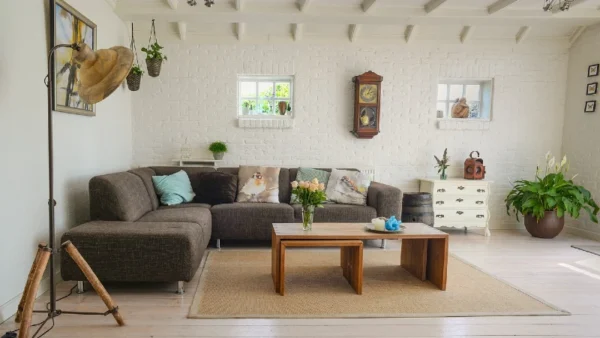Disclosure: This post may contain affiliate links, meaning we get a commission if you decide to make a purchase through our links, at no cost to you. Please read our disclosure for more info.
Last Updated on February 7, 2024 by Steal the Style
Creating a versatile living space is all about making your home adapt to your needs. It’s not just about following the latest trends; it’s about finding what works for you. In places like Naperville, Illinois, where the architecture ranges from classic to modern, homeowners have unique opportunities to transform their spaces.
Naperville, known for its charming blend of historic and contemporary styles, offers a great canvas for creating versatile living areas. Whether you’re in a century-old home near the vibrant downtown or in a newer house in the suburbs, these tips will help you make the most of your space. From consulting a roofing contractor about adding natural light to choosing the right color palette, every decision plays a part in creating a home that’s both functional and welcoming.
Let’s explore how you can turn your living space into a place that meets your changing needs and reflects your personal style.
In This Post:
Maximize Natural Light
Natural light can transform a living space. It makes rooms feel bigger and more welcoming. To bring in more sunlight, consider large windows or even a skylight. For those living in Illinois, consulting with Ladder Legends, a Naperville roofing contractor, can provide options for adding a skylight. This not only increases natural light but can also add a unique feature to your home. Additionally, the strategic placement of mirrors can enhance the natural light in a room, making the space feel more open and airy.
Multifunctional Furniture
In versatile living spaces, furniture that serves more than one purpose is key. For instance, a sofa bed can double as seating and a guest bed. Look for coffee tables with storage or dining tables that can extend for more guests. This approach is not just practical; it saves space too. Opt for pieces that fit your space and lifestyle. Remember, the right furniture can make a small room both cozy and functional.
Smart Storage Solutions
Creative storage solutions can keep your home organized and clutter-free. Think vertically: use shelves and tall cabinets to maximize wall space. Under-bed storage is great for seasonal items. In living areas, opt for furniture with built-in storage. This could be ottomans with storage space or entertainment units with extra shelves. The key is to find storage that blends with your decor while keeping your belongings accessible but out of sight.
Flexible Room Layouts
Adaptable room layouts allow you to change the function of a space as needed. Consider using lightweight furniture that’s easy to move. Room dividers or foldable screens can help in creating temporary sections in a large room. For instance, a divider can turn a section of the living room into a home office during the day. Rethink your space regularly, and don’t be afraid to rearrange furniture to suit different occasions or needs.
Indoor-Outdoor Flow
Creating a seamless transition between indoor and outdoor areas can effectively expand your living space. If you have a backyard or patio, consider doors that open wide to blend these areas. Use similar flooring materials inside and out to enhance the flow. Outdoor seating that complements your indoor decor can also tie the spaces together. This approach is perfect for entertaining or simply enjoying a more open, airy living environment.
Use of Color and Texture
Choosing the right colors and textures can greatly impact the versatility of your living space. On the other hand, incorporating bold colors can help separate different areas in a space. Adding textures can bring depth and interest. Items like rugs, throw pillows, and curtains are great for adding texture without overpowering the room. You can switch these items out with the seasons to give your room a fresh look without needing a full redesign.
Incorporating Technology
Modern technology can make your living space more adaptable and convenient. Smart lighting systems allow you to adjust the mood of a room with a simple voice command or a tap on your smartphone. Smart thermostats can improve the comfort and energy efficiency of your home. Wireless speakers and hidden charging stations can enhance your entertainment experience while keeping the space tidy. When incorporating technology, consider its aesthetic impact to ensure it blends seamlessly with your decor.
Adjustable Lighting
Adjustable lighting is a game-changer for creating versatile living spaces. Dimmer switches allow you to alter the ambiance of a room instantly. Consider different types of lighting: ambient for overall illumination, task lighting for specific activities, and accent lighting to highlight features. Layering these types can give you the flexibility to change the feel of a room depending on its use at any given time. Choosing the right light fixtures can also contribute to the room’s overall aesthetic.
Space-saving Wall Decor
Wall decor is a great way to add personality to your space without taking up valuable floor space. Floating shelves offer a place to display items without cluttering the room. Wall-mounted TVs or projectors can free up floor space. Use wall art to inject color and texture into a room. Remember, less is often more; choose a few statement pieces rather than crowding the wall with too many items.
Regular Updates and Maintenance
Keeping your living space updated and well-maintained is essential. Regular updates might include repainting, replacing worn-out furniture, or updating decor elements. Maintenance is also key. Fixing any damages promptly, ensuring that all fixtures and appliances are in good working order, and keeping the space clean will make it more enjoyable and versatile. Sometimes, a simple refresh can make a big difference.
Conclusion
In conclusion, creating a versatile living space is about making smart choices in design and functionality. It involves utilizing natural light, choosing multifunctional furniture, finding smart storage solutions, having flexible room layouts, and maintaining an indoor-outdoor flow. The use of color, texture, modern technology, adjustable lighting, and space-saving decor enhances this versatility.
Regular updates and maintenance ensure that the space remains functional and welcoming over time. Start small and remember that every change, whether it’s a new piece of furniture or a fresh coat of paint, brings you one step closer to achieving a living space that not only meets your needs but also adapts to them.

